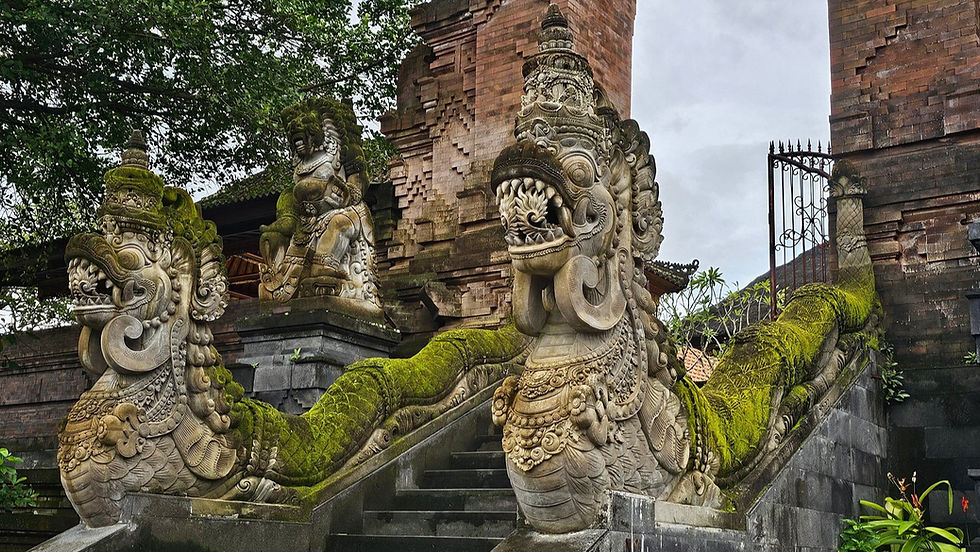Bedogol - The Gatekeepers
- Shannon
- Sep 1
- 3 min read
Updated: Sep 16
Standing Between Worlds - The Role of Bedogols in Balinese Culture
Across Bali, Bedogol refers to the guardian statues that flank the entrances of temples and family compounds, the silent watchers carved in stone. Positioned in pairs on either side of a gateway, they serve as spiritual protectors, anchoring the threshold between the ordinary world and sacred ground. Their forms vary widely. Some snarl with bulging eyes and sharp fangs, others take on serene human shapes, animal forms or divine figures. Despite their differences, their purpose remains the same, to guard the boundary between outer space and the sacred within, confronting whatever should not pass.

The Human and Divine Figures of Balinese Temples
Often linked to the Dwarapala figures of Hindu and Buddhist tradition, many Bedogol statues follow the classic mould of hulking forms with clenched jaws, bulging eyes and fanged mouths, carved to channel the fierce energy of Bhuta Kala, chaotic spirits ritually subdued and repurposed as guardians. These intimidating sentinels are commonly found at major temples and ancient shrines, where the symbolism leans into fear as a spiritual barrier. But not all Bedogols are monsters. Others appear as human figures, typically male and female pairs, the man wielding a staff or club, the woman holding a bowl or flower, both locked in a stance of poised vigilance. These gentler forms may embody ancestral spirits, divine protectors or guardians of the threshold, watching with quiet authority over the temple’s sacred core.
Zoomorphic Sentinels
Animal shaped Bedogols are also widespread, with carvings of lions, turtles, elephants, monkeys and serpent-like naga lining temple gates across the island. These forms aren’t chosen merely for aesthetics, they are deeply symbolic. The Naga embodies underground water forces and fertility, the lion stands for strength and royal power, while the turtle symbolises stability, endurance and a grounding connection to the earth. Each creature carries specific spiritual weight, selected not for beauty but for its ability to guard the space. In some temples, especially those shaped by regional traditions or older animist roots, these zoomorphic guardians take precedence, becoming the dominant presence at the gateway between worlds.

Balancing Light and Dark
The style of Bedogol statues shifts across regions, shaped by local tradition, temple age and the hands that carve them. In southern Bali, they tend to be finely detailed, moss-covered stone figures etched with precision and age. Further north or in rural villages, the carvings may lean toward the exaggerated or whimsical, blending sacred intent with a touch of everyday character. Despite these differences, one element remains consistent, most are wrapped in poleng cloth, the iconic black-and-white checkered textile that symbolises duality. It speaks to the Balinese belief in balance, light and dark, order and chaos. During temple rituals, offerings are placed at their feet or on their heads, a gesture of reverence that acknowledges the presence of spirit within the stone.
Living Elements of Bali’s Spiritual World
Deeply intertwined with the Balinese beliefs of sekala and niskala, the seen and unseen worlds, these statues play an active role in community spirituality. They are honoured during temple anniversaries, full moon ceremonies and key festivals such as Galungan and Kuningan. Through regular rituals involving cleansing with holy water and offerings, these guardians maintain a vital energetic balance crucial to their protective function. If neglected or disrespected, this balance may falter, potentially resulting in spiritual disturbances or illness. This is not out of anger but as a natural consequence of interrupted ritual care. Their upkeep symbolises a living agreement between the statues and those who tend to them. Additionally, their placement is carefully determined by the sacred architectural system of Asta Kosala Kosali, aligning each figure with cosmic harmony, energy flows and ritual purpose. This underscores a core truth in Balinese belief, that these figures are not passive art but living components of the island’s spiritual framework.

The Enduring Duty of Bedogols
Rooted in centuries of tradition and spiritual belief, Bedogols are far more than mere stone carvings, they are living thresholds made visible. As tangible markers of sacred space, they balance unseen energies and help maintain the delicate equilibrium between the human and divine realms. Whether bearing monstrous visages meant to repel malevolent forces or peaceful, serene forms that invite harmony, their design is never arbitrary. Each statue is carefully crafted to reflect the unique spiritual needs of the space it protects. These silent guardians stand with unwavering purpose and their role is clear and constant. They guard, always.

Thanks for reading about Bedogol - The Gatekeepers. Check out more amazing legends and awesome destinations here!

Bedogol - The Gatekeepers





















































